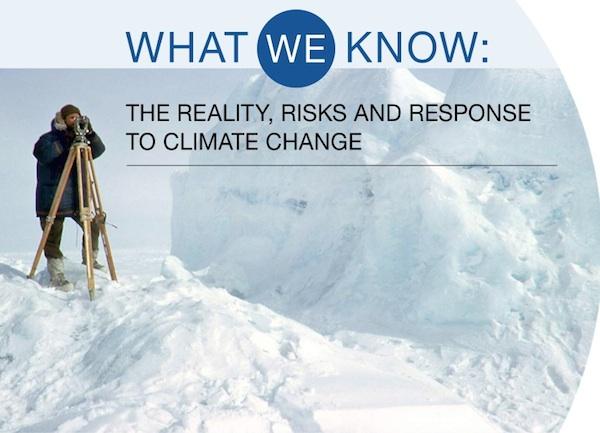Forget about reading, writing and ’rithmetic. Reality, risk and response are the new three Rs, scientists say, and the situation is dire.
The incremental changes taking place in the global climate will in the not-too-distant future add up to irreversible damage, says a new report from the American Association for the Advancement of Science (AAAS). Compiling all that is known to date about the changes taking place in Earth’s air, water and land, the U.S.’s top scientists are trying to get humanity to listen up.
“This new effort is intended to state very clearly the exceptionally strong evidence that Earth’s climate is changing, and that future climate change can seriously impact natural and societal systems,” said James McCarthy, Alexander Agassiz Professor of Biological Oceanography at Harvard University and one of three chairs of a panel that issued the 20-page report, What We Know: The Reality, Risks and Response to Climate Change. “Even among members of the broader public who already know about the evidence for climate change and what is causing it, some do not know the degree to which many climate scientists are concerned about the risks of possibly rapid and abrupt climate change.”
McCarthy is one of 13 panelists offering expertise on the matter via lectures, testimonials on a new website accompanying the report, and outreach to fellow professionals, the AAAS said in its media release.
“We’re the largest general scientific society in the world, and therefore we believe we have an obligation to inform the public and policymakers about what science is showing about any issue in modern life, and climate is a particularly pressing one,” said AAAS CEO Alan Leshner in the group’s statement. “As the voice of the scientific community, we need to share what we know and bring policymakers to the table to discuss how to deal with the issue.”
The first new R is Reality, the AAAS said.
“Climate scientists agree: Climate change is happening here and now,” the AAAS said, emphasizing that 97 percent of climate experts agree.
“The second [R] is Risk—that the reality of climate change means that there are climate change impacts we can expect, but we also must consider what might happen, especially the small, but real, chance that we may face abrupt changes with massively disruptive impacts,” the association said. “We are at risk of pushing our climate system toward abrupt, unpredictable, and potentially irreversible changes with highly damaging impacts.”
That leads to the third R.
“The third R is Response—that there is much we can do and that the sooner we respond, the better off we will be,” the AAAS said. “The sooner we act, the lower the risk and cost.”
Inaction, however, could exacerbate extreme weather conditions and cause, for example, crop failure and thus famine. Although many factors—ranging from variations in the Earth’s crust, to changes in orbit and tilt toward the sun—can cause climate changes, this time human activity is the main driver, the AAAS report said.
“Decades of human-generated greenhouse gases are now the major force driving the direction of climate change, currently overwhelming the effects of these other factors,” the AAAS report said. “Many studies show that the combined effects of natural drivers of climate cannot explain the temperature increase observed over the past half century.”
The full AAAS report is available for download, along with a huge volume of information, at the What We Know website.
“Climate change is already happening. More heat waves, greater sea level rise, and other changes with consequences for human health, natural ecosystems, and agriculture are already occurring in the United States and worldwide,” said the AAAS report, released on March 18. “These problems are very likely to become worse over the next 10-20 years and beyond.”
Read more at http://indiancountrytodaymedianetwork.com/2014/03/19/get-real-climate-change-scientists-cut-through-bluster-blunt-report-154072

